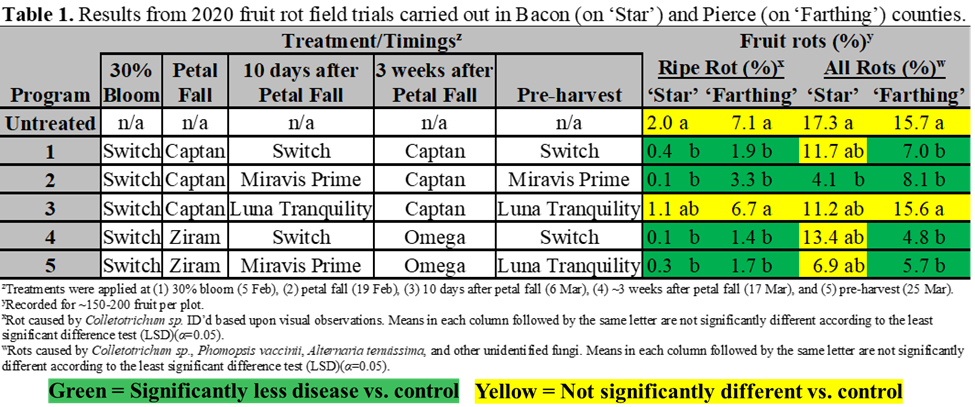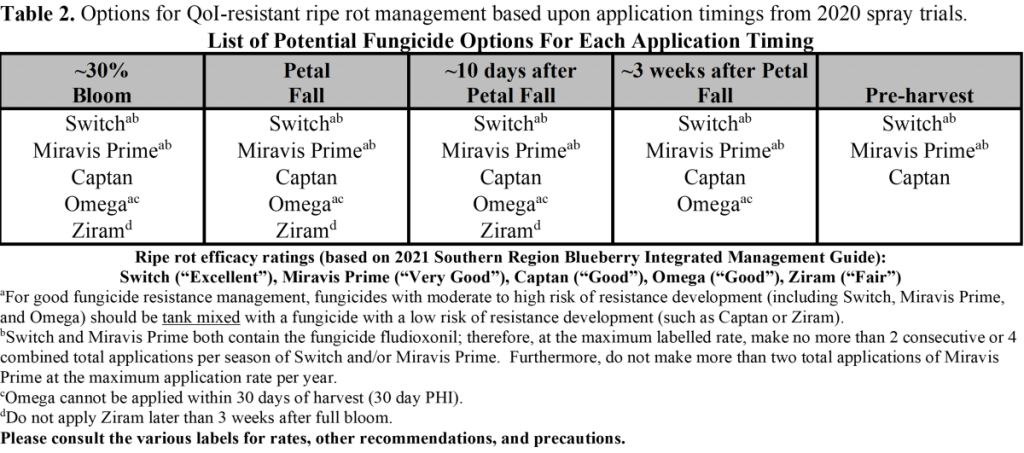By: Jonathan E. Oliver (UGA Fruit Pathologist), James Jacobs (UGA County Extension Coordinator, Pierce, Charlton, and Brantley Counties), Zack Williams (UGA County Extension Agent, Bacon County), Renee Holland (UGA Area Extension Agent – Commercial Blueberry)
Background
Anthracnose fruit rot of blueberry is caused by the fungi Colletotrichum acutatum and Colletotrichum gloeosporioides. This disease affects both southern highbush (SHB) and rabbiteye blueberries in the southeastern United States. Though this disease can also affect blossoms and shoots, it is primarily known for causing a destructive rot of ripe fruit called “ripe rot”. Ripe rot can affect fruit either before or after harvest, and can cause significant losses when warm, wet weather occurs during bloom or just prior to harvest. Though infection with ripe rot fungi can occur as early as bloom, symptoms typically don’t appear until fruit ripens. On infected fruit, salmon-colored spore masses can be produced (Figure 1) which allow the fungus to easily infect other fruit on the plant or other fruit in the same packing line or clamshell. As a result, ripe rot can cause significant losses in blueberry production. Typically, field losses due to ripe rot increase in successive pickings, and in poor storage conditions postharvest losses can approach 100%.

In commercial blueberry production, anthracnose fruit rot is managed through multiple applications of fungicides from bloom until harvest, with after-harvest applications used to manage anthracnose leaf spot. DMI (Demethylation Inhibitor) fungicides have proven to be relatively poor in their control of anthracnose fruit rot, while strobilurin or QoI (Quinone outside inhibitors) fungicides have been effective. Accordingly, blueberry growers in the southeastern US have relied heavily on QoI fungicides including Pristine and Abound, as well as broad-spectrum fungicides like Captan, for ripe rot control. However, in recent years, growers and packing houses have reported increasing problems with anthracnose, and Colletotrichum sp. isolates with resistance to QoI fungicides have been identified in blueberries in Florida, South Carolina, and Georgia.
Since blueberry growers in Georgia frequently rely on QoI fungicides for the management of ripe rot, it is important that alternative fungicidal recommendations be established to help growers manage ripe rot in the event that QoI fungicides become ineffective. The Southern Region Blueberry Integrated Management Guide recommends Abound, Pristine, Quilt Xcel, Switch, Captan, and Omega for ripe rot control; however, Omega is rarely used due to its long pre-harvest interval (30 days), while Abound, Pristine, and Quilt Xcel all include QoI fungicides. That leaves only Captan and Switch from this list in common use, and Switch is frequently relied upon for Botrytis management during bloom with the total applications per season limited by the label. To examine the efficacy of fungicide spray programs for managing anthracnose fruit rot, field trials were conducted in SHB blueberry plantings in Bacon and Pierce counties during the 2020 growing season.
Field Evaluation Methods
Two field trials were conducted during the 2020 growing season to evaluate fungicides for control of fruit rot on southern highbush blueberry. One trial was conducted on SHB cultivar ‘Star’ at the Blueberry Research Farm in Alma, GA. The second trial was conducted on SHB cultivar ‘Farthing’ at a commercial blueberry farm near Blackshear, GA where QoI resistant isolates of Colletotrichum had been identified previously. Fungicides were applied at 30% bloom (5 Feb), petal fall (19 Feb), 10 days after petal fall (6 Mar), ~3 weeks after petal fall (17 Mar), and pre-harvest (25 Mar). All treatments were applied until runoff (equivalent to 75 gal water/A) using a Solo backpack sprayer with an 8003 TeeJet spray tip. Chemical treatments consisted of five spray programs: (1) Switch 62.5WG and Captan Gold 4L, (2) Switch 62.5WG, Captan Gold 4L, and Miravis Prime, (3) Switch 62.5WG, Captan Gold 4L, and Luna Tranquility, (4) Switch 62.5WG, Ziram, and Omega 500F, and (5) Switch 62.5WG, Ziram, Miravis Prime, Omega 500F, and Luna Tranquility (Table 1). Five replications of each treatment and the untreated control were applied to a randomized complete block design, with each plot consisting of three sprayed plants, with one unsprayed plant separating each plot. All cultural practices were consistent with SHB blueberry production methods commonly observed in the Southeast. On 21 Apr (in Bacon County) and on 24 Apr and 14 May (in Pierce County), ~150-200 fruit were collected from the center plant in each plot and evaluated for rots based on visual signs within 36-48 hours of collection.
Trial Results and Discussion
Based upon the results of these field trials, fungicide programs incorporating Switch, Captan, Ziram, Omega, and/or Miravis Prime were the most successful at reducing the incidence of fruit rots in general and ripe rot specifically (Table 1). This is in agreement with the ripe rot efficacy ratings provided by the 2020 Southern Region Blueberry Integrated Management Guide, for Switch (‘Excellent’), Omega (‘Good’), Captan (‘Good’), and Ziram (‘Fair’). Miravis Prime has not been previously recommended in this guide, however, based partially upon these trial results, it was added to the 2021 edition of this guide with a rating of ‘Very Good’ for ripe rot control. By contrast, based upon the relatively poor performance of spray program 3 in this trial (which included two applications of Luna Tranquility), Luna Tranquility is not recommended for control of ripe rots or other fruit rots at this time.

Conclusions and Ripe Rot Management Recommendations
Taken together, these results suggest that QoI-resistant ripe rot can be managed using a rotation of Switch, Miravis Prime, Captan, Omega, and Ziram. Georgia blueberry growers who have experienced issues with Anthracnose ripe rot and other fruit rots are encouraged to incorporate these fungicides into their spray program during the bloom to pre-harvest period (Table 2).

Another important consideration for ripe rot management regards the use of DMI fungicides. While DMI fungicides (including Indar, Tilt, and Proline) are frequently using during the bloom to pre-harvest period (because they provide excellent control of mummy berry, Phomopsis twig blight, and leaf rust), the use of some DMI fungicides alone (such as Indar) has been shown previously to increase ripe rot severity. As a result, it is recommended that growers applying DMIs during the bloom and pre-harvest periods should tank mix DMI fungicides with captan to further reduce potential ripe rot problems.
For additional recommendations for disease control in conventional blueberry production, please see the Southeast Regional Blueberry Integrated Management Guide which can be found at www.smallfruits.org. Fungicide availability, labels, and recommended rates change frequently and vary between states and localities. Please consult the various labels for rates, other recommendations, and precautions. Always, refer to the labels of potential tank mix partners to determine if specific tank mixes are allowed or recommended prior to use. If you have further questions or concerns regarding the management of anthracnose ripe rot, please contact your county extension agent.